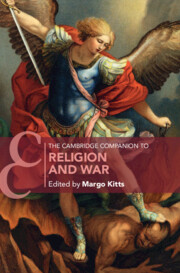Book contents
- The Cambridge Companion to Religion and War
- Cambridge Companions to Religion
- The Cambridge Companion to Religion and War
- Copyright page
- Contents
- Contributors
- Preface
- Introduction
- Part I Classical Foundations
- Part II Just War
- Part III Religious Nationalism
- 14 War in Religious Zionism
- 15 Christian Nationalism and Millennialism in the USA
- 16 The Elusive Dream of Pan-Islamism
- 17 Killing for the Hindu Nation
- 18 Nationalism, Violence and War in Myanmar’s Theravāda Buddhist Context
- Part IV Featured Conflicts
- Index
- Cambridge Companions to Religion (continued from page ii)
- References
17 - Killing for the Hindu Nation
Hindu Nationalism and Its Violent Excesses
from Part III - Religious Nationalism
Published online by Cambridge University Press: 04 May 2023
- The Cambridge Companion to Religion and War
- Cambridge Companions to Religion
- The Cambridge Companion to Religion and War
- Copyright page
- Contents
- Contributors
- Preface
- Introduction
- Part I Classical Foundations
- Part II Just War
- Part III Religious Nationalism
- 14 War in Religious Zionism
- 15 Christian Nationalism and Millennialism in the USA
- 16 The Elusive Dream of Pan-Islamism
- 17 Killing for the Hindu Nation
- 18 Nationalism, Violence and War in Myanmar’s Theravāda Buddhist Context
- Part IV Featured Conflicts
- Index
- Cambridge Companions to Religion (continued from page ii)
- References
Summary
What drives the increasingly violent impulses of Hindu nationalism in India? This chapter emphasizes the abyss between, on the one hand, its anxieties about Hindu minoritization and territorial dismemberment and, on the other, its retrotopian visions about revitalizing a purported Hindu golden age.
- Type
- Chapter
- Information
- The Cambridge Companion to Religion and War , pp. 349 - 368Publisher: Cambridge University PressPrint publication year: 2023



